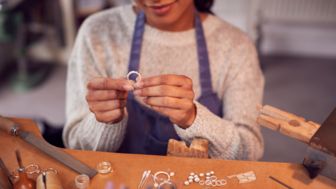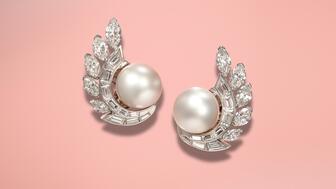The entrepreneur and “Shark Tank” star will share his top tips for success.
Squirrel Spotting: What Will Retail Look Like After COVID-19?
Consumers will return to physical stores, writes Peter Smith, and jewelers need to be ready for them.

“Everything will change after this.”
“It’ll be a new normal.”
You can’t avoid it. We’ve all become experts on snappy one-liners, devoid of context or the responsibility to justify our prognostications.
While we’ve never seen anything like COVID-19, if you are old enough, you’ve lived through 9/11 and the financial crisis. We heard similar prognostications during those dark days, predictions about how retail was going to fundamentally change thereafter, how nothing would ever be the same again.
Do you remember how 9/11 was going to result in a massive surge in marriages, as people sought to prioritize and, presumably, formalize connections with their loved ones?
It was a nice thought, and I’ve heard many references to how it happened in subsequent years. Problem is, it just isn’t true.
In the year prior to 9/11, 2000, there were 2.32 million marriages in the United States. The two years post-9/11 saw an average of 2.27 million marriages. The predictions didn’t materialize, but people still used the narrative afterward.
In the current crisis, I’m hearing about how we all have now been conditioned to shop online, a consequence of our isolation during the pandemic, and that our shopping habits hereafter will “never be the same.”
Apparently, we needed COVID-19 to learn that we can shop online and have things delivered to our homes. Who knew?
Here’s the problem with the online argument—it’s complete nonsense.
The idea that our evolutionary need to engage with other human beings, after 2 million years of genetic wiring, is going to suddenly accede to an isolation hangover from a few weeks or months at home is just not viable.
In “Reengineering Retail,” Doug Stephens wrote: “Shopping appeals to our deepest subconscious needs and goes deep within our psyche. We saw this profoundly after the 9/11 terrorist attacks in the United States. While many economists predicted a significant drop in consumer activity, which would have been understandable given the scale and nature of the tragedy, the exact opposite happened.
“Consumers bought more, much more. It’s a phenomenon scientists call mortality salience—the reality of one’s own impermanence—and it drives an increased desire for goods and services that provide people with a sense of comfort and stability.”
Being stuck in my home for weeks has not fueled a desire to spend more time at home. It hasn’t served to steel me to my “new normal.”
I want to go out and eat in restaurants. I want to go to the movies. I want to get back to attending shows and concerts, and I want to shop and be around other people.
I’ve enjoyed staying connected with my co-workers on Microsoft Teams and Zoom, and I have no doubt that the trend toward remote working will accelerate now that many of us have experienced what it feels like firsthand.
But it is not going to replace the fundamental need human beings have to be around other human beings.
In a Bain report issued last week, “Luxury after COVID-19: Changed for (the) Good?,” it was reported that the Chinese market “already appears to be on its way to recovery.”
While we can’t necessarily equate what happens in one market to another, there was further encouragement in the report: “Almost every luxury brand in China had to temporarily close stores or reduce working hours, creating double-digit year-over-year sales declines; however, at luxury stores that have since reopened, consumers are returning faster than expected.”
A friend of mine in Hong Kong expressed real surprise that mainland China’s retail sales for March were very strong, on the order of about 70 percent of a normal March. She indicated that some important sales were happening as people look to “cheer themselves up.”
We like to believe that a crisis brings out the best in people, that it serves to imbue people with a sense of community spirit, a concern for their fellow citizens. The sentiment has a lovely feel to it but it is, at its core, absolute rubbish.
Crisis reveals who we already are, only more so. If you were an ass going into it, you’ll be an even bigger ass in the throes of a crisis. Just look at all the people fighting over rolls of toilet paper!
If you are inherently a decent person, it’s more than likely that your positive attributes will be on full display in the midst of a crisis and you will exhibit selfless behaviors and positive actions throughout.
Character in crisis is a good metaphor for retail jewelers.
If your business model was suspect before COVID-19, it’ll be even more so when we get to the other side of this, if you are still in business. Your shortcomings will be exacerbated and failure to reinvent your business immediately will likely hasten your decline.
If, on the other hand, your business model was healthy going into this crisis—and you manage to come out of this mess intact—you can double-down on your model and intensify your efforts to build on the aspects of your business that made you relevant in the first place.
So, what does that mean post-COVID-19? In retail, it is these five things.
Having Good Salespeople Will Be Paramount
For starters, we’ve witnessed a decline in foot traffic for years and that won’t change anytime soon. To that end, doing a better job of converting customer traffic into sales has never be more critical.
To improve your close ratio, you cannot afford to have salespeople who are not wired to sell.
Can you really afford to continue to miss sales in your well-intentioned, but otherwise self-defeating, effort to retain pleasant and/or tenured salespeople if they are not effective sales drivers?
Average Price Points Must Increase
Average retail tickets have increased over the past three years or so in the independent jewelry channel. That is good news, and it needs to continue for the math to work.
If you’re the guy looking to lower your average ticket in a world where you are selling fewer units, you are going to run into a phenomenon called the math doesn’t work.
This is not the time to embrace a cheaper-is-better strategy.
Generic Is Not a Compelling Story
One of the most misunderstood aspects of branding is the power of storytelling.
Carmine Gallo wrote in “The Storyteller’s Secret,” that “Facts and figures inform, but stories move people to action.”
Your differentiation comes not from how much you can afford to discount a generic product, but in how compelling your story and relevance is to prospective customers.
Value is what the consumer gets (how it makes them feel), not what they pay for it.
A narrative built disproportionally on being a “multi-generational business with great customer service” is not compelling or differentiated.
We’ve seen too many retailers close their doors for good after multiple generations in business and a real commitment to serving their communities. In and of itself, those attributes are not enough.
A finite number of stories presented really well will become more important than ever in a world where the customer does not want to work too hard to figure out what your store is about.
Online Must Be Part of Your Strategy
If you currently have an online presence, then present circumstances should have underscored the importance of being able to conduct some business even in a lockdown situation.
If you don’t have the ability to conduct meaningful business online, the lockdown should be the last reminder you need to get it done now.
Having a solid online presence is essential to driving customers and sales into your retail store.
It has been reported that as much as 85 percent of all brick-and-mortar sales start online. There is also the matter of actually being able to generate as much as 15 to 20 percent of future business digitally.
And So Must the Store Experience
This would be an awfully good time to rethink the physical layout of your store. Removing clutter and shifting things around in advance of a post-coronavirus world might be a very good use of your time.
There are a great many things you can do to reset your store, your team and your product offerings.
Making faster decisions as a business has never been more important, and taking calculated risks to break free of conventions that used to govern your actions will be more important than ever.
In “Remarkable Retail,” Steve Dennis wrote, “Beyond the as-yet-unwritten story of the ravages of this outbreak and the magnitude of its tragic human toll, the spread of the coronavirus seems certain to accelerate the collapse of the middle and push many other weak retailers (and the industries that serve them) over the edge.”
Don’t be the guy in the middle. Rekindle the fire and come out of this with a renewed passion and purpose.
I’m very positive about retail going forward and I hope you are too.
The Latest

The Ukrainian brand’s new pendant is modeled after a traditional paska, a pastry often baked for Easter in Eastern European cultures.

The “Strong Like Mom” campaign features moms who work at Tiffany & Co. and their children.

Interior designer Athena Calderone looked to decor from the 1920s and 1930s when crafting her first fine jewelry collection.


During a call about its full-year results, CEO Efraim Grinberg discussed how the company is approaching the uncertainty surrounding tariffs.

The free program provides educational content for jewelry salespeople and enthusiasts to learn or refresh their diamond knowledge.

Bench jewelers spend years honing their skills, Jewelers of America’s Certification validates their talents.

The feedback will be used to prepare other jewelers for the challenges ahead, the organization said.

The online sessions are designed to teach jewelers to use AI tools like ChatGPT and Claude to grow their business.

The “United in Love” collection offers tangible mementos of hearts entwined with traditional and non-traditional commitment heirlooms.

Robert Goodman Jewelers will hold a “Black Jewelry Designers and Makers” event on April 27.

The announcements follow a tumultuous start to 2025 for WJA, which saw a wave of resignations following controversial statements about DEI.

Editor-in-Chief Michelle Graff answers questions about how the new taxes levied on countries like India and China will impact the industry.

Kenewendo, Botswana’s minster of minerals and energy, discusses closing the deal with De Beers and the work that was missed along the way.

The historic fancy vivid blue diamond set to headline Christie’s Geneva sale next month could sell for up to $50 million.

LVMH CFO Cécile Cabanis also discussed the effects of tariffs so far.

The “Mad Men” and “The Morning Show” star steals jewelry, art, and handbags from his wealthy neighbors in “Your Friends & Neighbors.”

The organization has reelected Kalpesh Jhaveri as president.

An investigation found that the former managing director of Movado’s Dubai branch overstated and prematurely recorded sales.

The collection pays tribute to the Japanese philosophy of Ma, studying balance, stillness, and the interplay between presence and absence.

Mari Lou’s Fine Jewelry in Orland Park, a suburb of Chicago, is closing its doors.

GIA’s labs in Dubai and Hong Kong are now accepting larger diamonds in light of the “logistical challenges” presented by the new tariffs.

These earrings by Van Cleef & Arpels, featuring the same design as a pair worn by Princess Grace, are up for auction at Woolley & Wallis.

Two experts share how artificial intelligence tools can help retailers run a more efficient business.

Kentaro Nishimura, who has been with the pearl company since 1997, has been promoted to president and CEO of Mikimoto America.

“America Telling Time: 150 Years of Bulova” explores the storied history of the American watchmaker.




























